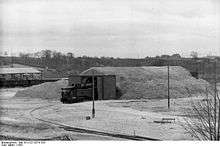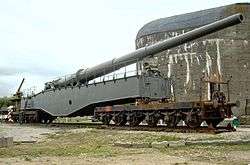Krupp K5
| 28-cm-Kanone 5 (E) | |
|---|---|
|
K5 railway gun in France 1945 c. | |
| Type | Railway Gun |
| Place of origin | Nazi Germany |
| Service history | |
| Used by | Wehrmacht |
| Wars | World War II |
| Production history | |
| Manufacturer | Krupp |
| Number built | 25 |
| Specifications | |
| Weight | 218 t (215 long tons; 240 short tons) |
| Length |
Travel: 30 m (98 ft) Combat: 32 m (105 ft) |
| Barrel length | 21.539 m (70 ft 8 in) L/76.1 |
|
| |
| Shell | 255 kg (562 lb) |
| Caliber | 283 mm (11.1 in) |
| Elevation | +50° |
| Traverse | 2° |
| Rate of fire | 15 rounds per hour |
| Muzzle velocity | 1,120 m/s (3,675 ft/s) |
| Maximum firing range | 64 km (40 mi) |
The Krupp 28-cm-Kanone 5 (E), in short K5 with the (E) signifying Eisenbahnlafette (railway car gun-mount), was a heavy railway gun used by Germany throughout World War II.
Description
Krupp's K5 series were consistent in mounting a 21.5 metres (71 ft) long gun barrel in a fixed mounting with only vertical elevation of the weapon. This gondola was then mounted on a pair of 12-wheel bogies designed to be operated on commercial and military rails built to German standards. This mounting permitted only two degrees of horizontal traverse. The carriage had to be aligned on the rails first, with only minimal fine leveling capable once halted. Hence the gun could only fire at targets tangential to an existing railway track.
To track targets needing greater traverse either a curved length of railway was used with the gun shunted backwards or forwards to aim; a cross-track was laid with the front bogie turned perpendicular to the rest of the gun and moved up and down the cross-track to train the weapon; or for 360 degree traverse, the so-called "Vögele Turntable" could be constructed, consisting of a raised rail section (the "firing bed") carrying the gun, running on a circular track with a central jack to raise the gun during traverse and to take some of the enormous weight.
The main barrel of the K5 is 283 mm (11.1 in) in calibre (caliber), and is rifled with twelve 7 mm (0.28 in) grooves. These were originally 10 mm (0.39 in) deep, but were shallowed to rectify cracking problems.
History

The K5 was the result of a crash program launched in the 1930s to develop a force of railway guns to support the Wehrmacht by 1939. K5 development began in 1934 with first testing following in 1936 at the Firing Test Range Rügenwalde-Bad (German: Schießplatz Rügenwalde-Bad) in Farther Pomerania at the South coast of the Baltic Sea. Initial tests were done with a 150 mm barrel under the designation K5M.
Production led to eight guns being in service for the Invasion of France, although problems were encountered with barrel splitting and rectified with changes to the rifling. The guns were then reliable until the end of the war, under the designation K5 Tiefzug 7 mm. Three of them were installed on the English Channel coast to target British shipping in the Channel, but proved unsuccessful at this task.
Towards the end of the war, development was done to allow the K5 to fire rocket-assisted projectiles to increase range. Successful implementation was done for firing these from the K5Vz.
A final experiment was to bore out two of the weapons to 310 mm (12.2 in) smoothbore to allow firing of the Peenemünder Pfeilgeschosse arrow shells. The two modified weapons were designated K5 Glatt.
Several other proposals were made to modify or create new models of the K5 which never saw production. In particular, there were plans for a model which could leave the railway by use of specially modified Tiger II tank chassis which would support the mounting box in much the same manner as the railway weapon's two bogies. This project was ended by the defeat of Germany.
Projectiles
Two types of high explosive projectile were used with the K5. The 28cm G35 weighed 255 kilograms (562 lb) and contained a charge of 30.5 kilograms (67 lb) of TNT. The 28cm Gr.39 m. Hbgr. Z. was slightly heavier, weighing 265 kilograms (584 lb) and containing around 44.5 kilograms (98 lb) of TNT.
The rocket-boosted shell was known as the 28cm R. GR.4351. This carried 14 kilograms (31 lb) of explosive and was boosted by around 20 kilograms (40 lb) of double-base powder rocket propellent. The total weight was 248 kilograms (547 lb).[1]
Surviving guns
A K5(E) is preserved at the United States Army Ordnance Museum in Fort Lee (Petersburg, Virginia). Leopold was shipped to the U.S. Aberdeen Proving Ground, (Aberdeen, Maryland) where it underwent tests and evaluations. In early 2011 it was moved to Fort Lee, Virginia (37°15′01″N 77°20′26″W / 37.250338°N 77.340492°W) as a result of the 2005 Base Relocation and Closure (BRAC) Act.
The guns were discovered on a railroad siding in the town of Civitavecchia, on 7 June 1944, shortly after the allies occupied Rome.[2] Robert had been partially destroyed by the gun crew before they surrendered and Leopold was also damaged but not as badly.
A second surviving gun can be seen at the Batterie Todt museum, near Audinghen in northern France.[3]
|
See also
Notes and references
- Notes
- ↑ German Explosive Ordnance (Technical report). Departments of the Army and the Air Force. March 1953. pp. 527–529. Department of the Army Technical Manual TM9-1985-3.
- ↑ "The Ordnance Department, On Beachhead and Battlefront". United States Army in World War II. United States Army Center of Military History. 1991 [1968]. p. 200. CMH Pub 10-11, Library of Congress Catalog Card Number: 67-60000 http://www.history.army.mil/books/wwii/Beachhd_Btlefrnt/. Missing or empty
|title=(help) - ↑ Batterie Todt museum website
- References
- Wildenboer, Louis (June 2005). "Anzio Annie the story of a gun". 13 (3). South African Military History Society. Retrieved 20 July 2011.
- Engelmann, Joachim (1976). Armor in Action - German Railroad Guns. Squadron/Signal Publications. ISBN 0-89747-048-6.
- Ulrich Ziervogel: Der Schießplatz in Rügenwalde-Bad, in: Der Kreis Schlawe - Ein pommersches Heimatbuch (M. Vollack, ed.), Vol. I: Der Kreis als Ganzes, Husum 1986, ISBN 3-88042-239-7, pp. 284–296.
- O'Rourke, R.J. (1995). Anzio Annie : she was no lady (1st ed.). Fort Washington, Md. ISBN 978-0-9645084-0-8.
External links
| Wikimedia Commons has media related to Krupp K5 railway gun. |
Coordinates: 50°48′50″N 1°45′17″E / 50.81389°N 1.75472°E



